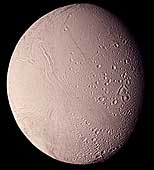
Saturn II
Enceladus [en-SELL-ah-dus] is one of the innermost moons of Saturn. It is quite similar in size to Mimas but has a smoother, brighter surface. Enceladus reflects almost 100 percent of the sunlight that strikes it. Unlike Mimas, Enceladus displays at least five different types of terrain. Parts of Enceladus shows craters no larger than 35 km in diameter. Other areas show regions with no craters indicating major resurfacing events in the geologically recent past. There are fissures, plains, corrugated terrain and other crustal deformations. All of this indicates that the interior of the moon may be liquid today, even though it should have frozen aeons ago. It is postulated that Enceladus is heated by a tidal mechanism similar to Jupiter's moon Io. It is perturbed in its orbit by Saturn's gravitational field and by the large neighboring satellites Tethys and Dione. Because Enceladus reflects so much sunlight, the surface temperature is only -201° C (-330° F).
Additional Articles
- Scientists Study 'Plumbing' in Plumes of Enceladus
- Saturn's Giant Sponge
- A Hot Start Might Explain Geysers on Enceladus
- Radical! Liquid Water on Enceladus
| Enceladus Statistics | |
|---|---|
| Discovered by | William Herschel |
| Date of discovery | 1789 |
| Mass (kg) | 8.40e+19 |
| Mass (Earth = 1) | 1.4056e-05 |
| Equatorial radius (km) | 250 |
| Equatorial radius (Earth = 1) | 3.9197e-02 |
| Mean density (gm/cm^3) | 1.24 |
| Mean distance from Saturn (km) | 238,020 |
| Rotational period (days) | 1.370218 |
| Orbital period (days) | 1.370218 |
| Mean orbital velocity (km/sec) | 12.64 |
| Orbital eccentricity | 0.0045 |
| Orbital inclination (degrees) | 0.02 |
| Escape velocity (km/sec) | 0.212 |
| Visual geometric albedo | 0.99 |
| Mean surface temperature | -201°C |
| Magnitude (Vo) | 11.7 |
- Video on water on Enceladus.
- Voyager: Flight over Enceladus.
- Cassini: Zooming In On Enceladus (Movie)
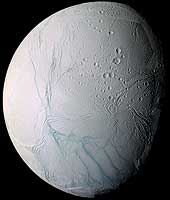 Zooming In On Enceladus (Mosaic)
Zooming In On Enceladus (Mosaic)
As it swooped past the south pole of Saturn's moon Enceladus on July 14,
2005, Cassini acquired high resolution views of this puzzling ice world.
From afar, Enceladus exhibits a bizarre mixture of softened craters and
complex, fractured terrains.
This large mosaic of 21 narrow-angle camera images have been arranged to provide a full-disk view of the anti-Saturn hemisphere on Enceladus. This mosaic is a false-color view that includes images taken at wavelengths from the ultraviolet to the infrared portion of the spectrum, and is similar to another, lower resolution false-color view obtained during the flyby (see PIA06249). In false-color, many long fractures on Enceladus exhibit a pronounced difference in color (represented here in blue) from the surrounding terrain.
A leading explanation for the difference in color is that the walls of the fractures expose outcrops of coarse-grained ice that are free of the powdery surface materials that mantle flat-lying surfaces.
The original images in the false-color mosaic range in resolution from
350 to 67 meters (1,148 to 220 feet) per pixel and were taken at distances
ranging from 61,300 to 11,100 kilometers (38,090 to 6,897 miles) from
Enceladus. The mosaic is also part of a movie sequence of images from this
flyby (see PIA06253).
(Courtesy NASA/JPL/Space Science Institute)
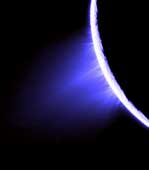 Jet Blue
Jet Blue
Cassini imaging scientists used views like this one to help them identify
the source locations for individual jets spurting ice particles, water
vapor and trace organic compounds from the surface of Saturn's moon
Enceladus.
Their study -- published in the Oct. 11, 2007, issue of the journal Nature -- identifies eight source locations, all on the prominent tiger stripe fractures, or sulci, in the moon's south polar region. Some of the sources occur in regions not yet observed by Cassini's composite infrared spectrometer, and the researchers predict that future Cassini observations of those locations will find elevated temperatures.
This false-color view was created by combining three clear filter images taken at nearly the same time as PIA07759. This image product was then specially processed to enhance the individual jets that compose the plume. (PIA07759 was instead processed to reveal subtleties in the brightness of the overall plume that comprises the jets.) Some artifacts due to the processing are present in the image. The final product was colored as blue for dramatic effect.
The images were acquired with the Cassini spacecraft narrow-angle camera
on Nov. 27, 2005 at a distance of approximately 148,000 kilometers (92,000
miles) from Enceladus and at a sun-Enceladus-spacecraft, or phase, angle
of 161 degrees. Scale in the original images is about 880 meters (0.5
mile) per pixel. This view has been magnified by a factor of two from the
original images.
(Courtesy NASA/JPL/Space Science Institute)
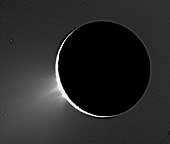 Fountains of Enceladus
Fountains of Enceladus
Recent Cassini images of Saturn's moon Enceladus backlit by the sun show
the fountain-like sources of the fine spray of material that towers over
the south polar region. This image was taken looking more or less
broadside at the "tiger stripe" fractures observed in earlier Enceladus
images. It shows discrete plumes of a variety of apparent sizes above the
limb of the moon.
(Courtesy NASA/JPL/Space Science Institute)
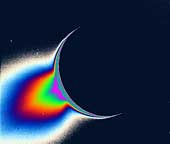 Fountains of Enceladus - Image #2
Fountains of Enceladus - Image #2
Recent Cassini images of Saturn's moon Enceladus backlit by the sun show
the fountain-like sources of the fine spray of material that towers over
the south polar region. The image was taken looking more or less broadside
at the "tiger stripe" fractures observed in earlier Enceladus images. It
shows discrete plumes of a variety of apparent sizes above the limb of the
moon.
The greatly enhanced and colorized image shows the enormous extent of the
fainter, larger-scale component of the plume.
(Courtesy NASA/JPL/Space Science Institute)
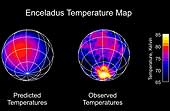 Enceladus Temperature Map
Enceladus Temperature Map
This image shows the surprise that startled Cassini scientists on the
composite infrared spectrometer team when they got their first look at the
infrared (heat) radiation from the south pole of Saturn's moon Enceladus.
There is a dramatic warm spot centered on the pole that is probably a sign of internal heat leaking out of the icy moon. The data were taken during the spacecraft's third flyby of this intriguing moon on July 14, 2005.
Based on data from previous flybys, which did not show the south pole well, team members expected that the south pole would be very cold, as shown in the left panel. Enceladus is one of the coldest places in the Saturn system because its extremely bright surface reflects 80 percent of the sunlight that hits it, so only 20 percent is available to heat the surface. As on Earth, the poles should be even colder than the equator because the sun shines at such an oblique angle there.
The right hand panel shows a global temperature image made from measurements of Enceladus' heat radiation at wavelengths between 9 and 16.5 microns. Cassini made the observation from a distance of 84,000 kilometers (52,000 miles) on the approach to Enceladus, and the image shows details as small as 25 kilometers (16 miles). Equatorial temperatures are much as expected, topping out at about 80 degrees Kelvin (-315 degrees Fahrenheit), but the south pole is occupied by a well-defined warm region reaching 85 Kelvin (-305 degrees Fahrenheit). That is 15 degrees Kelvin (27 degrees Fahrenheit) warmer than expected. The composite infrared spectrometer data further suggest that small areas of the pole are at even higher temperatures, well over 110 degrees Kelvin (-261 degrees Fahrenheit). Evaporation of this relatively warm ice probably generates the cloud of water vapor detected above Enceladus' south pole by several other Cassini instruments.
The south polar temperatures are very difficult to explain if sunlight is
the only energy source heating the surface, though exotic
sunlight-trapping mechanisms have not yet been completely ruled out. It
therefore seems likely that portions of the polar region are warmed by
heat escaping from the interior of the moon. This would make Enceladus
only the third solid body in the solar system, after Earth and Jupiter's
volcanic moon Io, where hot spots powered by internal heat have been
detected.
(Courtesy NASA/JPL/GSFC)
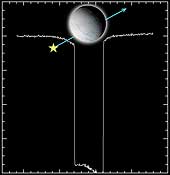 Enceladus Atmosphere -- Star Struck
Enceladus Atmosphere -- Star Struck
During the July 14, 2005, flyby of Saturn's moon Enceladus, Cassini's
ultraviolet imaging spectrograph made the first direct detection of an
atmosphere, first suggested by Cassini magnetometer measurements.
The ultraviolet imaging spectrograph observed the star Gamma Orionis as Enceladus crossed in front of the star. The light of the star dimmed as it was obscured by the atmosphere before being blocked entirely by Enceladus itself. The spectrum of the starlight changed as it passed through the atmosphere, indicating the presence of water vapor.
The ultraviolet imaging spectrograph results suggest that the atmosphere
of Enceladus is not constant and may be consistent with a greater amount
of atmospheric gas near the south polar region. The presence of water
vapor is more consistent with warm water ice than with magnetospheric
sputtering.
(Courtesy NASA/JPL/University of Colorado)
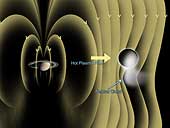 Enceladus Atmosphere (Artist's Concept)
Enceladus Atmosphere (Artist's Concept)
This artist concept shows the detection of a dynamic atmosphere on
Saturn's icy moon Enceladus. The Cassini magnetometer instrument is
designed to measure the magnitude and direction of the magnetic fields of
Saturn and its moons. During Cassini's three close flybys of Enceladus --
Feb. 17, March 9 and July 14, 2005--the instrument detected a bending of
the magnetic field around Enceladus due to electric currents generated by
the interaction of atmospheric particles and the magnetosphere of Saturn.
The graphic shows the magnetic field observed by Cassini, as well as the
predicted neutral cloud being vented from the south pole. Cassini's
magnetometer observed bending of the magnetic field consistent with its
draping around a conducting object. That indicates that the Saturnian
plasma is being diverted away from an extended atmosphere.
(Courtesy NASA/JPL)
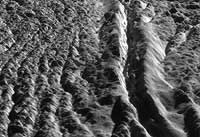 Perspective view of Damascus Sulcus, Enceladus
Perspective view of Damascus Sulcus, Enceladus
This perspective view of Damascus Sulcus was generated using high
resolution images of Enceladus acquired in August 2008 at 12 to 30 meters
(40 to 100 feet) resolution, together with a new topographic map of the
region produced by Dr. Paul Schenk at
the Lunar and Planetary Institute in Houston, TX. Damascus Sulcus is one
of several prominent linear structures, dubbed "tiger stripes," within the
geologically active south polar region of Enceladus. Damascus Sulcus
consists of two large parallel ridges separated by a deep V-shaped medial
trough. The ridges are each 100 to 150 meters high (325 to 500 feet),
while the entire width of Damascus Sulcus is 5 kilometers (3 miles). The
medial trough between the ridges is 200 to 250 meters (650 to 820 feet)
deep, and may have formed by daily shear (sliding) faulting triggered by
tidal forces. These medial troughs may be the primary source of numerous
jets making up the large active water vapor plume over the south pole of
Enceladus. Several small ridges can be seen along the floor of the medial
trough. These could be blocks of crust that have slid down the walls of
the trough or fractured blocks pushed up from below. Flanking Damascus
Sulcus are repeating sets of broken and disrupted parallel ridges a few
tens of meters high. These are typical of the plains that lie between the
tiger stripe structures and resemble crumpled or folded rock patterns seen
on Earth. Relief has been exaggerated by a factor of ~10 to enhance
clarity.
(Courtesy NASA/JPL/Space Science Institute/Universities Space Research Association/Lunar & Planetary Institute)
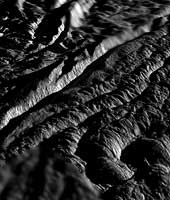 Perspective view of Cairo Sulcus, Enceladus
Perspective view of Cairo Sulcus, Enceladus
This perspective view of Cairo Sulcus was generated using high resolution
images of Enceladus acquired in August 2008 at 12 to 30 meters (40 to 100
feet) resolution, together with a new topographic map of the region
produced by Dr. Paul Schenk at the Lunar and
Planetary Institute in Houston, TX. Lower resolution images to either side
were acquired at 50 to 80 meter (165 to 260 feet) resolution. Cairo Sulcus
is one of several prominent structures, dubbed "tiger stripes," within the
geologically active south polar region of Enceladus. These structures
consist of two large parallel ridges up to 2 kilometers (1.2 miles) across
separated by a deep V-shaped medial trough. This view highlights one of
the wall scarps of the medial trough of Cairo Sulcus, the brightly lit
scarp crossing the left-hand side of the view. This wall scarp stands 175
to 250 meters (575 to 820 feet) high. Vertical striations and large
boulders tens of meters across clutter the surface of this scarp, evidence
of faulting and/or slumping of crustal ices. Troughs such as these are
probably the source of numerous jets making up the large active water
vapor plume over the south pole of Enceladus. The parallel sets of rounded
mounds and ridges In the foreground are up to 50 meters (165 feet) high.
These are typical of the plains that lie between the tiger stripe
structures and resemble crumpled or folded rock patterns seen on Earth.
Relief has been exaggerated by a factor of ~10 to enhance clarity.
(Courtesy NASA/JPL/Space Science Institute/Universities Space Research Association/Lunar & Planetary Institute)
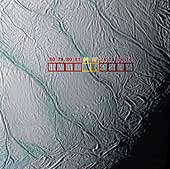 Warm Fractures on Enceladus
Warm Fractures on Enceladus
This image shows the warmest places in the south polar region of Saturn's
moon Enceladus. The unexpected temperatures were discovered by Cassini's
composite infrared spectrometer during a close flyby on July 14, 2005. The
image shows how these temperatures correspond to the prominent, bluish
fractures dubbed "tiger stripes," first imaged by Cassini's imaging
science subsystem cameras. Working together the two teams were able to
pinpoint the exact location of the warmest regions on Enceladus.
The composite infrared spectrometer instrument measured the infrared heat radiation from the surface at wavelengths between 9 and 16.5 microns within each of the 10 squares shown here. Each square is 6 kilometers (4 miles) across. The color of each square, and the number shown above it, describe the composite infrared spectrometer's measurement of the approximate average temperature of the surface within that square.
The warmest temperature squares, at 91 and 89 degrees Kelvin (minus 296 and minus 299 degrees Fahrenheit), are located over one of the "tiger stripe" fractures. They contrast sharply with the surrounding temperatures, which are in the range 74 to 81 degrees Kelvin (minus 326 to minus 313 degrees Fahrenheit). The detailed composite infrared spectrometer data suggest that small areas near the fracture are at substantially higher temperatures, well over 100 degrees Kelvin (minus 279 degrees Fahrenheit). Such "warm" temperatures are unlikely to be due to heating of the surface by the feeble sunlight striking Enceladus' south pole. They are a strong indication that internal heat is leaking out of Enceladus and warming the surface along these fractures. Evaporation of this relatively warm ice probably generates the cloud of water vapor detected above Enceladus' south pole by several other Cassini instruments. Scientists are unsure how the internal heat reaches the surface. The process might involve liquid water, slushy brine, or soft but solid ice.
The imaging science subsystem image is an enhanced color view with a pixel
scale of 122 meters (400 feet) that was acquired at the same time as the
composite infrared spectrometer data. It covers a region 125 kilometers
(75 miles) across. The spacecraft's distance from Enceladus was 21,000
kilometers (13,000 miles). The broad bluer fractures that can be seen
running from the upper left to the lower right of the image are 1 to 2
kilometers (0.6 to 1.2 miles) wide and more than 100 kilometers (60 miles)
long. The fractures are thought to be bluer than the surrounding surface
because coarser-grained ice (which has a blue color just as thick masses
of ice, like glaciers and icebergs, do on Earth) has been exposed in the
fractures. The color image was constructed using an ultraviolet filter
(centered at 338 nanometers) in the blue channel, a clear filter in the
green channel, and an infrared filter (centered at 930 nanometers) in the
red channel.
(Courtesy NASA/JPL/GSFC/Space Science Institute)
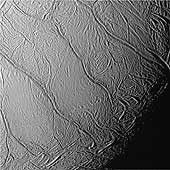 Tiger Stripes Up Close
Tiger Stripes Up Close
This close-up view of Saturn's moon Enceladus looks toward the moon's
terminator (the transition from day to night) and shows a distinctive
pattern of continuous, ridged, slightly curved and roughly parallel
faults within the moon's southern polar latitudes. These surface features
have been informally referred to by imaging scientists as "tiger stripes"
due to their distinctly stripe-like appearance when viewed in false color
(see PIA06249).
Illumination of the scene is from the lower left. The image was obtained
in visible light with the Cassini spacecraft narrow-angle camera on July
14, 2005, at a distance of about 20,720 kilometers (12,880 miles) from
Enceladus, and at a Sun-Enceladus-spacecraft, or phase, angle of 46
degrees. The image scale is 122 meters (400 feet) per pixel. The image's
contrast has been enhanced to aid visibility of surface features.
(Courtesy NASA/JPL/Space Science Institute)
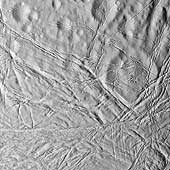 Craters and Cracks
Craters and Cracks
This dramatic scene from Cassini illustrates an array of processes on
Saturn's moon Enceladus, a once geologically active world. Most of the
larger craters appear to have softened from their original, presumably
crisp appearance, and are cross-cut here by numerous faults.
Cassini acquired this high-resolution view of Enceladus during its closest encounter yet with any moon of Saturn.
Toward the bottom of the scene, terrain containing fractured and softened craters gives way to essentially non-cratered terrain consisting of tectonic faults.
The softened craters, fractured plains and wrinkled terrain on Enceladus suggest geologic activity has taken place in several episodes during the satellite's history. This activity might continue into the present time, although imaging team scientists have seen no evidence for current activity on the moon.
Illumination of the scene is from the left. The image was obtained in
visible light with the Cassini spacecraft narrow-angle camera on July 14,
2005, at a distance of about 11,500 kilometers (7,150 miles) from
Enceladus, and at a Sun-Enceladus-spacecraft, or phase, angle of 46
degrees. The image scale is 67 meters (220 feet) per pixel. The image's
contrast has been enhanced to aid visibility of surface features.
(Courtesy NASA/JPL/Space Science Institute)
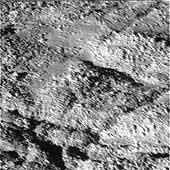 Boulder-Strewn Surface -- Narrow Angle Camera View
Boulder-Strewn Surface -- Narrow Angle Camera View
The tortured southern polar terrain of Enceladus appears strewn with great
boulders of ice in this fantastic view, one of the highest resolution
images obtained so far by Cassini of any world.
Some smearing of the image due to spacecraft motion is apparent in this scene, which was acquired as Enceladus raced past Cassini's field of view near the time of closest approach. At the time, the imaging cameras were pointed close to the moon's limb (edge), rather than directly below the spacecraft. This allowed for less motion blur than would have been apparent had the cameras pointed straight down. Thus, the terrain imaged here was actually at a distance of 319 kilometers (198 miles) from Cassini.
At this fine scale, the surface is dominated by ice blocks between 10 and 100 meters (33 and 330 feet) across. The origin of these icy boulders is enigmatic. Scientists are interested in studying the sizes and numbers of the blocks in this bizarre scene, and in understanding whether terrain covered with boulders is common on Enceladus.
A wide-angle camera view centered on this location on Enceladus is available (see PIA06251), as well as a comparison view showing the position of this image within the wide-angle image (see PIA06250).
The image was taken during Cassini's very close flyby of Enceladus on
July 14, 2005, from a distance of approximately 208 kilometers (129 miles)
above Enceladus. Resolution in the image is about 4 meters (13 feet) per
pixel. The image has been contrast enhanced to improve the visibility of
surface.
(Courtesy NASA/JPL/Space Science Institute)
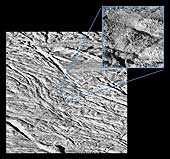 Boulder-Strewn Surface
Boulder-Strewn Surface
The tortured southern polar terrain of Saturn's moon Enceladus appears
strewn with great boulders of ice in these two fantastic views -- the
highest resolution images obtained so far by Cassini of any world.
This comparison view consists of a wide-angle camera image (left) for context, and a high-resolution narrow-angle camera image (right). The two images were acquired at an altitude of approximately 208 kilometers (129 miles), as Cassini made its closest approach yet to Enceladus.
The wide-angle view shows what appears to be a geologically youthful, tectonically fractured terrain.
In the narrow-angle view, some smearing of the image due to spacecraft motion is apparent. Both of these views were acquired as Enceladus raced past Cassini's field of view near the time of closest approach. At the time, the imaging cameras were pointed close to the moon's limb (edge), rather than directly below the spacecraft. This allowed for less 'motion blur' than would have been apparent had the cameras pointed straight down. Thus, the terrain imaged here was actually at a distance of 319 kilometers (198 miles) from Cassini.
At the fine scale afforded by the Cassini spacecraft narrow-angle view, the surface is dominated by ice blocks between 10 and 100 meters (33 and 330 feet) across. The origin of these icy boulders is enigmatic. Scientists are interested in studying the sizes and numbers of the blocks in this bizarre scene, and in understanding whether terrain covered with boulders is common on Enceladus.
The images in this comparison view are available individually (see PIA06251 and PIA06252).
Image scale is about 4 meters (13 feet) per pixel in the narrow-angle
image and about 37 meters (121 feet) per pixel in the wide-angle image.
The wide-angle image has been magnified by a factor of two. The contrast
in both images has been enhanced to improve the visibility of surface
features.
(Courtesy NASA/JPL/Space Science Institute)
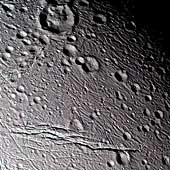 Painting on the Walls
Painting on the Walls
During its closest flyby of Saturn's wrinkled, icy moon Enceladus,
Cassini obtained multi-spectral images of its cratered terrain that have
been put together to create this false-color view.
To human eyes, Enceladus appears almost completely white, but false color reveals intriguing details. This view is a composite of images taken using filters sensitive to ultraviolet (centered at 338 nanometers), green (centered at 568 nanometers), and near-infrared (centered at 930 nanometers) light, and has been processed to accentuate subtle color differences. The uppermost surface of these terrains appears uniformly grey in this picture, suggesting that they are covered with materials of homogeneous composition and grain size. However, the walls of many of the fractures appear to be somewhat bluer than typical surface materials. It is possible that the difference in color identifies outcrops of solid ice on the walls of fractures, or ice with different grain-sizes, compared to powdery surface materials. It is also possible that the color identifies some compositional difference between buried ice and ice at the surface.
The surface is peppered with craters of all sizes, from the 21-kilometer (13-mile) diameter crater at the top of the image, down to tiny craters near the limit of resolution. The prominent crater at the top contains a central, domelike structure more than 11 kilometers (7 miles) in diameter. The dome, the crater--and indeed the entire scene--is sliced by a complex network of fractures ranging in width from hundreds of meters in some places, to over three kilometers (2 miles) in others.
The prominent, complex fracture in the bottom of the frame extends over 85 kilometers (53 miles) in length across the field of view. From Cassini's oblique vantage point, the walls of the large fracture are clearly visible. A pervasive network of narrow, parallel grooves can be seen in many places in the image, and they appear to slice the surface into parallel slabs of ice approximately 500 meters (1,600 feet) in thickness.
The image has been rotated so that north is at the top of the scene. The terrain in this scene is located on the side of Enceladus that faces away from Saturn, centered on latitude 28.7 north, longitude 192.5 west.
The image was taken during Cassini's closest-ever approach to Enceladus
on March 9, 2005. It was taken with the Cassini spacecraft narrow-angle
camera at a distance of approximately 21,300 kilometers (13,200 miles)
from Enceladus and at a Sun-Enceladus-spacecraft, or phase, angle of 45
degrees. Resolution in the image is about 130 meters (430 feet) per pixel.
(Courtesy NASA/JPL/Space Science Institute)
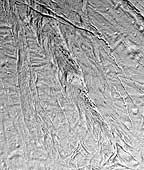 Seeing Enceladus' Faults
Seeing Enceladus' Faults
This high-resolution image from Cassini shows a region of "smooth plains"
terrain on the surface of Saturn's moon Enceladus, located slightly north
of the equator on the moon's Saturn-facing hemisphere. The area is 70
kilometer by 84 kilometer (43 mile by 52 miles).
The image shows a variety of tectonic features that attest to Enceladus' dynamic geological history. At the top of the image is a relatively fresh-looking crevasse system with individual fractures more than a kilometer wide. The crevasse system cross-cuts a complex northeast-to-southwest-trending system of older faults. A 12-kilometer-wide (7-mile-wide) band of crudely aligned, chevron-shaped features runs down the center of the image.
Among the most intriguing features in this view are a series of dark, small spots, 125 to 750 meters (400 to 2,500 feet) in diameter. The dark spots often seem to be aligned in chains parallel to narrow fractures. The contrast of the dark features with the surrounding bright terrain suggests that they may be compositionally distinct, but their origin is a new mystery.
The orientation of the image is such that north is approximately 30 degrees clockwise from the bottom of the frame. Enceladus is 505 kilometers (314 miles) in diameter.
The image was taken in visible light with the Cassini spacecraft narrow
angle camera on Feb. 17, 2005, at a distance of 21,208 kilometers (13,178
miles) from Enceladus and at a Sun-Enceladus-spacecraft, or phase, angle
of 27 degrees. Pixel scale in the image is 125 meters (410 feet) per
pixel. The image has been contrast-enhanced to aid visibility.
(Courtesy NASA/JPL/Space Science Institute)
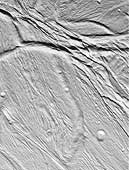 Cassini Views Enceladus Up-Close
Cassini Views Enceladus Up-Close
Stereo Image of Cassini Views Enceladus
Cassini took this image of the ropy, taffy-like topography on Saturn's
moon Enceladus as it soared above the icy moon on Feb. 17, 2005.
This view, about 60 kilometers across (37 miles), shows several different kinds of ridge-and-trough topography, indicative of a variety of horizontal forces near the surface of this 505-kilometer (314-mile) diameter satellite.
Several different kinds of deformation are visible, and a small population of impact craters shows that this is some of the younger terrain on Enceladus. Sunlight illuminates the scene from the bottom.
Interestingly, the topographic relief is only about one kilometer, which is quite low for a small, low gravity satellite. However, this is consistent with other evidence that points to interior melting and resurfacing in Enceladus' history.
This view was obtained in visible light with the Cassini spacecraft
narrow angle camera, at a distance of 10,750 kilometers (6,680 miles)
from Enceladus, and at Sun-Enceladus-spacecraft, or phase, angle of 32
degrees. Image scale is 60 meters (197 feet) per pixel. The image has
been contrast-enhanced to aid visibility.
(Courtesy NASA/JPL/Space Science Institute)
 Bright Moon in Darkness
Bright Moon in Darkness
In the dim light of the outer solar system, Cassini gazed back at Saturn's
brightest gem - the moon Enceladus. The icy little world presents only a
slim crescent in this natural color view.
When seen from its day side, Enceladus (499 kilometers, or 310 miles
across) has one of the brightest and whitest surfaces in the solar
system. Since it reflects most of the sunlight that strikes it, the
temperature there remains at a chilly -200 degrees Celsius (-330 degrees
Fahrenheit).
(Courtesy NASA/JPL/Space Science Institute)

 Saturn
Saturn Mimas
Mimas Tethys
Tethys